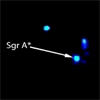CXC Home | Search | Help | Image Use Policy | Latest Images | Privacy | Accessibility | Glossary | Q&A
Tour of Sagittarius A*
Quicktime MPEG
Over several years, astronomers have noticed flares in X-ray light from the black hole at the center of the Milky Way. NASA's Chandra X-ray Observatory detected these flares during the telescope's periodic observations of the black hole. A new study suggests that these flares may occur when the black hole - known as Sagittarrius A* or Sgr A* for short -- consumes an asteroid at least six miles wide. If an asteroid gets too close to another object like a star or planet, it can be thrown into an orbit headed toward Sgr A*. Once the asteroid passes within about 100 million miles of the black hole, it is torn into pieces by the black hole's tidal forces. Eventually, these fragments are vaporized by friction as they pass through the hot, thin gas flowing onto Sgr A*. This is what produces an X-ray flare. If confirmed, this result could mean that there is a cloud around Sgr A* containing trillions of asteroids and comets. This would be an exciting development for the many scientists who are fascinated by the Milky Way's giant black hole and the environment around it.
[Runtime: 01:17]
Quicktime MPEG
Over several years, astronomers have noticed flares in X-ray light from the black hole at the center of the Milky Way. NASA's Chandra X-ray Observatory detected these flares during the telescope's periodic observations of the black hole. A new study suggests that these flares may occur when the black hole - known as Sagittarrius A* or Sgr A* for short -- consumes an asteroid at least six miles wide. If an asteroid gets too close to another object like a star or planet, it can be thrown into an orbit headed toward Sgr A*. Once the asteroid passes within about 100 million miles of the black hole, it is torn into pieces by the black hole's tidal forces. Eventually, these fragments are vaporized by friction as they pass through the hot, thin gas flowing onto Sgr A*. This is what produces an X-ray flare. If confirmed, this result could mean that there is a cloud around Sgr A* containing trillions of asteroids and comets. This would be an exciting development for the many scientists who are fascinated by the Milky Way's giant black hole and the environment around it.
[Runtime: 01:17]
(Credit: NASA/CXC/A. Hobart)
Chandra Movie of Flares From Milky Way's Supermassive Black Hole
Quicktime MPEG
Over several years, astronomers have noticed flares in X-ray light from the black hole at the center of the Milky Way known as Sagittarius A*, or Sgr A* for short. This movie shows flares from Sgr A*, using intermittent observations with Chandra between 1999 and 2007. The flares are seen about once a day and a new study suggests that they may occur when the black hole consumes an asteroid at least 12 miles wide.
[Runtime: 00:55]
Quicktime MPEG
Over several years, astronomers have noticed flares in X-ray light from the black hole at the center of the Milky Way known as Sagittarius A*, or Sgr A* for short. This movie shows flares from Sgr A*, using intermittent observations with Chandra between 1999 and 2007. The flares are seen about once a day and a new study suggests that they may occur when the black hole consumes an asteroid at least 12 miles wide.
[Runtime: 00:55]
(Credit: NASA/CXC/MIT/F.Baganoff et al.)
Artist's Illustrations of Asteroid Path to Black Hole
Quicktime MPEG
If an asteroid passes too close to another object such as a star or planet, it can be thrown into an orbit headed towards Sgr A*, as seen in this series of artist's illustrations. Once the asteroid passes within about 100 million miles of the black hole, it is torn into pieces by the black hole's tidal forces. These fragments are vaporized by friction as they pass through the hot, thin gas flowing onto Sgr A*. This is what produces the X-ray flare, and eventually the remains of the asteroid are swallowed by the black hole.
View Stills
[Runtime: 00:29]
Quicktime MPEG
If an asteroid passes too close to another object such as a star or planet, it can be thrown into an orbit headed towards Sgr A*, as seen in this series of artist's illustrations. Once the asteroid passes within about 100 million miles of the black hole, it is torn into pieces by the black hole's tidal forces. These fragments are vaporized by friction as they pass through the hot, thin gas flowing onto Sgr A*. This is what produces the X-ray flare, and eventually the remains of the asteroid are swallowed by the black hole.
View Stills
[Runtime: 00:29]
(Credit: NASA/CXC/M. Weiss)
Return to Sagittarius A* (February 8, 2012)





